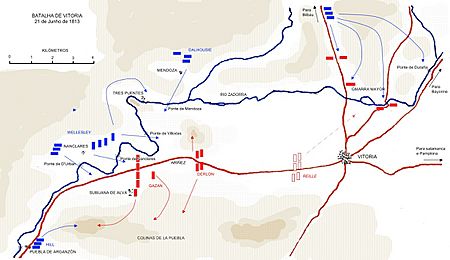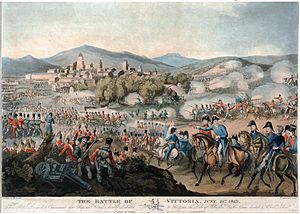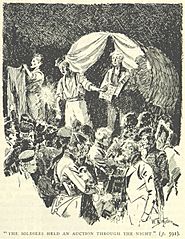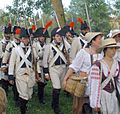Battle of Vitoria facts for kids
Quick facts for kids Battle of Vitoria |
|||||||
|---|---|---|---|---|---|---|---|
| Part of the Peninsular War | |||||||
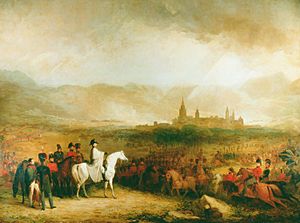 Painting by George Jones |
|||||||
|
|||||||
| Belligerents | |||||||
| Commanders and leaders | |||||||
|
|
|
||||||
| Strength | |||||||
| 57,000-60,000 153 guns |
Total Allied strength: 81,000-90,000 96 guns |
||||||
| Casualties and losses | |||||||
|
756 killed Total French casualties: 7,970 |
Total Allied casualties in detail: 840 killed 4,040 wounded 266 captured Total Allied casualties: 5,158 |
||||||
The Battle of Vitoria was a major fight that happened on June 21, 1813. It was a key moment in the Peninsular War. In this battle, a combined army from Britain, Portugal, and Spain fought against the French army. The Allied forces were led by the Marquess of Wellington. The French army was led by King Joseph Bonaparte and Marshal Jean-Baptiste Jourdan. The battle took place near Vitoria in Spain. The Allied army won, which helped them win the entire Peninsular War.
Contents
Why the Battle Happened
In July 1812, after the Battle of Salamanca, the French army left Madrid. Wellington's army then entered Madrid on August 12, 1812. Wellington then marched north to try and capture the fortress of Burgos. But he misjudged how strong the French were there. On October 21, he had to stop the Siege of Burgos and retreat.
By October 31, he also left Madrid. He moved his army back towards the Portuguese border to avoid being surrounded by French armies. Wellington spent the winter making his army stronger. He planned to attack King Joseph in Madrid again.
Meanwhile, Napoleon called many soldiers back to France. This was because his army had suffered huge losses during his terrible invasion of Russia. By May 20, 1813, Wellington led about 121,000 soldiers from northern Portugal. They marched across the mountains of northern Spain. This move helped them get around Marshal Jourdan's French army.
The French army was spread out between the Douro and Tagus rivers. They had about 68,000 soldiers. The French then retreated to Burgos. Wellington's forces marched quickly to stop them from reaching the road to France. Wellington himself led a smaller group in the middle as a trick. At the same time, Sir Thomas Graham led most of the army around the French right side. They went through land that was thought to be impossible to cross.
Wellington started his attack at Vitoria on June 21. He had 57,000 British, 16,000 Portuguese, and 8,000 Spanish soldiers. They attacked from four different directions.
The Land Around Vitoria
The battle took place around the Zadorra River. This river flows from east to west. As it goes west, it makes a big loop before turning southwest. To the south of the battlefield are the Heights of La Puebla. To the northwest is a large hill called Monte Arrato. Vitoria itself is to the east, about 3 kilometers south of the Zadorra River. Five roads lead out of Vitoria in different directions.
Plans for the Battle
On June 20, Marshal Jourdan was sick with a fever. Because of this, the French army didn't get many orders and just waited. A huge train of wagons filled with stolen goods blocked the streets of Vitoria. One convoy left during the night. But they had to leave their large siege cannons behind. They didn't have enough animals to pull them.
General Gazan's divisions guarded the narrow western part of the Zadorra valley. They were positioned south of the river. Further back, d'Erlon's force stood in a second line, also south of the river. D'Erlon failed to destroy three bridges near the river's bend. Reille's men were originally in a third line. But one of his divisions was sent north of the river to guard the Bilbao road.
Wellington planned for his Right Column, led by Hill, to push the French out of the valley on the south side of the river. While the French were busy with Hill, Wellington's Right Centre column moved along the north bank of the river. They crossed it behind the French right side. Graham's Left Column went around the north side of Monte Arrato. It then moved down the Bilbao road, aiming to cut off the main French army. Dalhousie's Left Centre column crossed Monte Arrato. It attacked the river east of the bend, connecting Graham and Wellington.
The Battle Unfolds
Wellington's plan involved four attacking groups. They would hit the French from the south, west, and north. The last group would cut off the French from behind. Coming up the Burgos road, Hill sent one division to climb the Heights of La Puebla. Another division began to spread out in the narrow plain south of the river. When Gazan saw this, he sent his troops forward to push the Spanish off the heights. Hill sent more troops to help. Gazan then sent his reserve division to join the fight on the heights.
Around this time, Gazan saw Wellington's column moving north of the Zadorra. They were trying to get around his right side. He asked Jourdan for more soldiers. But Jourdan was worried about his own left side. He refused to help Gazan. Instead, he ordered some of d'Erlon's troops to guard the Logroño road.
Wellington pushed one of his brigades across the Zadorra at the river bend. At the same time, another British general took a village called Subijana. Gazan's divisions counterattacked. On the heights, a British commander was killed. But the combined British and Spanish forces held their ground. Wellington paused his attacks to let Graham's column get into position. A quiet period settled over the battlefield.
At noon, Graham's column appeared on the Bilbao road. Jourdan quickly realized his army was in danger of being surrounded. He ordered Gazan to pull back towards Vitoria. Graham pushed one French division back across the river. But he couldn't force his way across the Zadorra, even after tough fighting. Further east, Spanish troops defeated the Spanish Royal Guards. They cut off the road to Bayonne, which was the French escape route.
With some help, Picton's 3rd Division crossed to the south side of the river. According to Picton, the French fired many cannons at them. They also counter-attacked on the right side of the 3rd Division. This caused the 3rd Division to lose many men. But they held their ground. Another division, Cole's 4th, crossed further west. The French tried to make a stand at the village of Arinez. But Wellington's attacking divisions quickly captured this spot. The French then fell back to the Zuazo ridge. Their many cannons protected them well. But this position also fell to Wellington's attack. This happened because Gazan refused to work with d'Erlon.
French morale completely broke down. Soldiers from Gazan and d'Erlon's groups ran away from the battle. Cannon operators left their guns behind as they fled. Soon, the road was jammed with wagons and carriages. Reille's two divisions bravely held off Graham. This allowed thousands of French troops to escape using the Salvatierra road.
What Happened Next
The Allied army lost about 5,000 soldiers. This included 3,675 British, 921 Portuguese, and 562 Spanish soldiers. The French lost at least 5,200 killed and wounded. They also had 2,800 men and 151 cannons captured.
The French didn't lose even more soldiers for a few reasons. First, the Allied army had already marched about 32 kilometers that morning. They were too tired to chase the French far. Second, Reille's men bravely stopped Graham's column. Third, the valley where the French retreated was narrow. Two French cavalry regiments protected the rear. Finally, the French left their valuable stolen goods behind.
Many British soldiers stopped to take things from the abandoned French wagons. These wagons held "the loot of a kingdom." It's thought that over £1 million worth of goods was taken. This caused a lot of chaos and a lack of discipline. Wellington was very angry about this.
Order was soon brought back. By December, after capturing San Sebastián and Pamplona, Wellington's army was in France. The defeat of Napoleon eventually ended the Peninsular War. This was followed by the Battle of Toulouse and the Battle of Bayonne.
Lasting Impact
The Battle of Vitoria inspired Beethoven to write his famous piece, Opus 91. It is often called the "Battle Symphony" or "Wellington's Victory". This music tells the story of the battle.
The movie The Firefly, starring Jeanette MacDonald, has the climax of the film during Wellington's attack.
The battle and the French retreat are also a big part of Bernard Cornwell's book Sharpe's Honour.
Reenactment
22 June 2013, Bicentenary of the Battle
Monuments and Memorials
See also
 In Spanish: Batalla de Vitoria para niños
In Spanish: Batalla de Vitoria para niños


